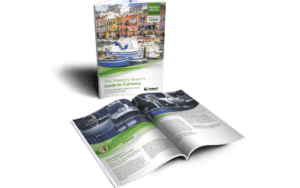Whether due to eco-concerns or pure traveling pleasure, many property owners in France see accessibility by train, ferry or (electric) car, rather than flying, as a vital part of their property search. France is even attracting more buyers who are unwilling to fly to Spain and other Mediterranean hotspots. With many of us keen to do our bit where possible, what are the alternative modes of green travel to France?
Find homes in France via our property portal.
Impact of green travel to and in France
While some people remain unconcerned about climate disruption, others have been convinced that far from being a myth, global warming is a real treat to the planet, and are keen to do their bit. The Swedes even have a name for this reluctance to take to the skies – flygskam or “flight shame.
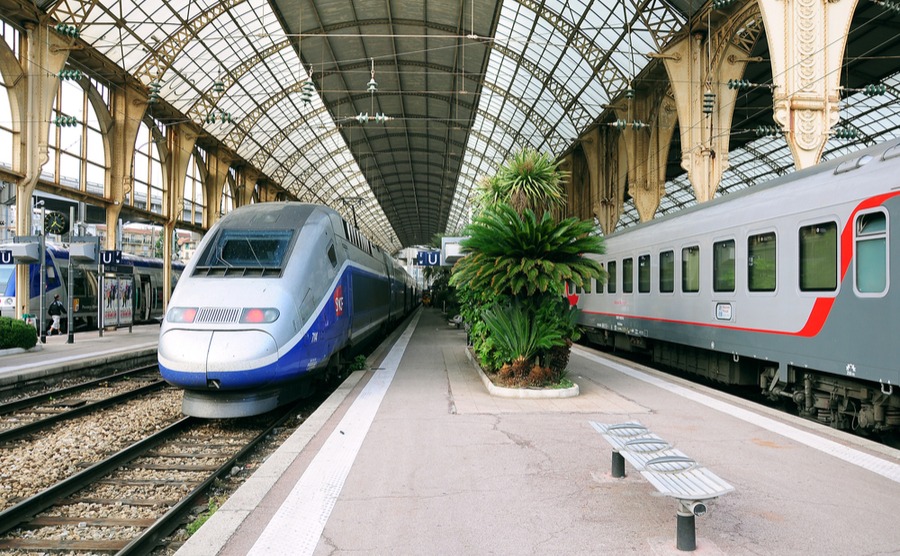
How realistic is taking the train as a method of green travel in France? Serjio74 / Shutterstock.com
In order to see how much more sustainable train travel is over transport by air, we’ve done a rough comparison of the carbon dioxide output (CO2) per passenger between London and three of the most popular cities in France, CO2 being one of the most important contributors to global warming.
As you can see, taking the train can cut emissions by an impressive 90%. What’s more, train travel is less stressful and often less costly than flying, when you consider the hassle of airport check in procedures and the time and expenses involved in travelling to distant airports and the price of parking.
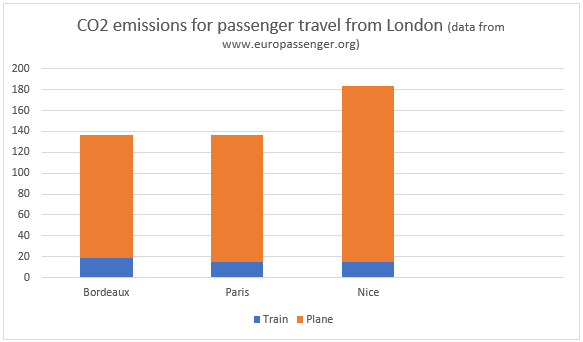
Picture yourself gliding through beautiful countryside in an air-conditioned carriage, with plenty of legroom, space for more than a pocket-sized suitcase, a glass of red wine in hand, and your own picnic lunch by your side – inexpensive to prepare and full of banned substances like soft cheese and pâté – and you may never fly again!
Is green travel to France realistic?
So, is it realistic to own a home and get here by methods of green travel in France? Yes! In fact, many great holiday destinations are just as easy to reach by train as by plane, and what’s more, you’ll enjoy the pleasure of riding in some of the world’s fastest and most efficient trains.
If you’re about to buy your dream home, or you’re starting your search, don’t miss your free guide, How to Negotiate Abroad, to help yourself get the best possible price.
If you start your journey in London, Eurostar’s regular service from St. Pancras to Paris Nord (journey time 2 hours 15 minutes) will connect you to the Société Nationale des Chemins de Fer (SNCF) network of Trains à Grand Vitesse (TGV) and regional trains that will whisk you to the four corners of France. It’s easy to book French trains, with SNCF offering an English version website where you can browse and book online.
How much do French train tickets cost and what are the trains like?
It’s possible to reserve a ticket up to four months in advance, and the earlier you book, the more attractive the offers, with first class tickets often costing only a few euros more than second class travel.
As an example, a passenger booking in April for a peak season trip in August, can find a ticket between Paris and Marseille for as little as €19 euros in second class (provided you are willing to get up with the birds at 6am), or €49 for travel at 9am second class, with a first-class ticket available for €55. Senior and younger travellers can obtain discounted fares, with no need for a special pass other than an ID card showing your date of birth.
It’s possible to reserve a ticket up to four months in advance, and the earlier you book, the more attractive the offers, with first class tickets often costing only a few euros more than second class travel.
French trains are generally spacious and comfortable, even on provincial lines, with the wider gauge of French railway tracks allowing for larger seats and generous corridors through which to wheel your luggage. Some lines even have old-fashioned compartments for six to eight passengers, and cycles and pets are allowed on many routes. If you have a paper ticket, be sure to validate it before travel by passing it through one of the yellow composteurs at the station – those with smartphones can download an e-billet to present to the guard on board.
Find homes in France via our property portal.
What about if I need to use a car?
If you’re determined to go by car (and who can deny the attractions of bringing back a crate or two of delicious local wines), then you can also cut your emissions by letting the train at least part of the strain. SNCF’s specially-designed car-trains will carry your vehicle between Paris, Avignon, Marseille, Toulon, St. Raphael or Nice while you follow on at your own pace in a scheduled TGV.
Car transport is undeniably a convenient and cost-effective way to travel if you have a family, or if you are setting-up your holiday home in France and need to transport furniture or personal belongings, but there is, of course, the channel to navigate, even if it only 10 miles across at its narrowest point!
Taking the ferry to France
To reach the northern French ports of Dunkirk and Calais, P&O and DFDS offer 90-minute sailings from Dover, and Eurotunnel’s le shuttle service operates from Ashurst in Kent with a journey time of 35 minutes and an impressive 54 daily crossings. Costs vary throughout the year, but with a bit of forward planning it’s possible to travel with a car and two passengers for as little as £43 each way by sea in low season, with Eurotunnel offering fares from around £175 for a return trip.
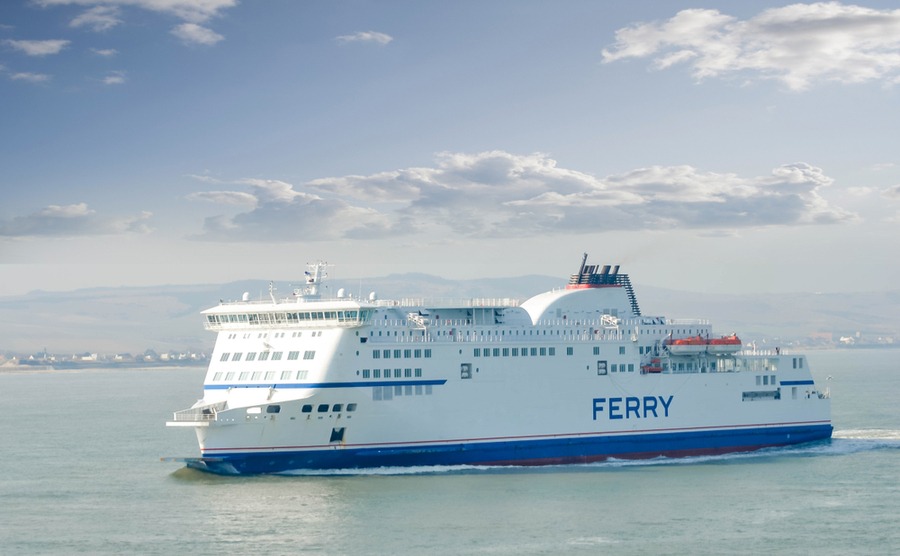
The ferry is a pleasant and green way to travel to France.
For frequent travellers to France, those who love cruising, and holidaymakers keen to avoid travel via Paris to reach Normandy, Brittany and beyond, Brittany Ferries offer crossings from Portsmouth and Poole to Cherbourg, Caen, Le Havre and St Malo.
Brittany Ferries boats boast full service restaurants, pet-friendly cabins as well as cinemas and attractions for children, and their popular travel club (cost around £75 per annum plus joining fee) offers members up to 30% discount on crossings. While peak season prices can top £400 return for a car and passengers, when you travel at quieter times of the year, prices are significantly lower at around £180 per round trip, with the added benefit of arriving in France well fed, rested and ready for onward green travel in France.
For frequent travellers to France, those who love cruising, and holidaymakers keen to avoid travel via Paris to reach Normandy, Brittany and beyond, Brittany Ferries offer crossings from Portsmouth and Poole to Cherbourg, Caen, Le Havre and St Malo.
Where can you easily reach without a car?
So, if you’re keen to take the plunge, here’s a brief look at a handful of popular cities and towns easily accessible by train and offering a wide variety of attractive properties in which you could make your very own home-from-home in France.
Find homes in France via our property portal.
Bourg St Maurice
Bourg St. Maurice. With trains to London taking around 8 hours via Paris (direct in high season), Bourg St Maurice is an ideal destination to explore the vast Paradiski area, accessible via funicular railway from the town centre. Property prices in this attractive town are lower than those at altitude, with prices averaging €3,300 per square metre. Stock up on local delicacies like Tomme de Savoie cheese and smoked hams during your stay from the pretty little shops in the old town and dine at much more reasonable prices than in the mountain resorts.
Nice
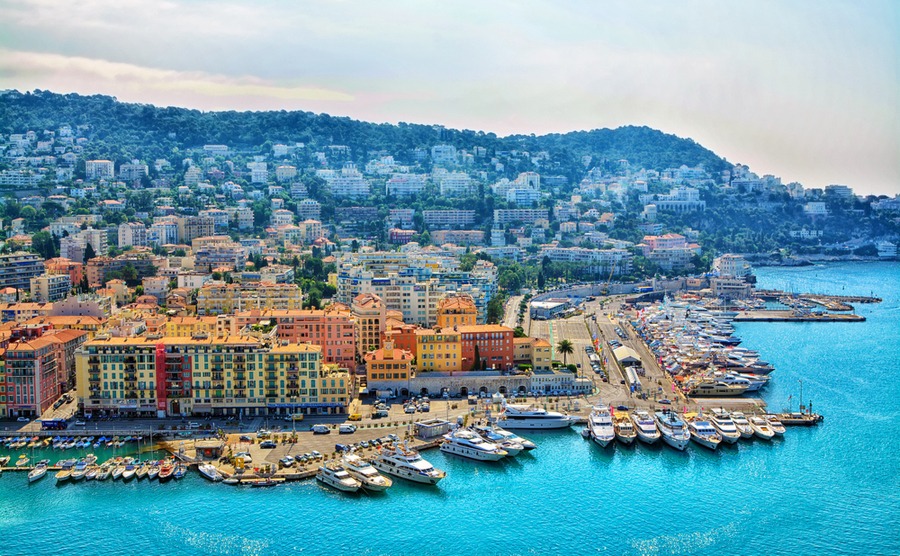
Yes, you can reach as far south as Nice without setting foot on a plane!
Nice. With its ochre-coloured old town, and its position on the Mediterranean, Nice was a long-time favourite resort of the British upper classes. Whilst Nice itself is a busy metropolis, the mountains behind the coast are fabulous areas to visit, and a small train known locally as the Train des Pignes winds its way up through the hills – you can make a stop by request and enjoy spectacular walking in unspoilt countryside. Property in Nice averages around €4,200 per square metre, although in Digne-les-Bains, the Train des Pignes‘ final destination, you will pay as little as €2,500. Journey times from London are around 12 hours.
Nantes
Nantes. With an outstanding quality of life, Nantes in Brittany was awarded the European Green Capital award in 2013. Nantes has a young population and a vibrant feel, the city has a great public transport system, and the municipality is making strides towards reducing air pollution and CO2 emissions. Nantes is roughly 6 hours from London by train, and you can pick up a property there for around €3,250 per square metre.
Have you got your tickets to Your Overseas Home yet? It’s a special kind of property show, aimed only at serious buyers, so you can get detailed information from lawyers, agents and currency providers.
Tours
Tours. Less than one hour by train to Paris, Tours is a popular starting point for visits to the Loire Valley and its chateaux, as well as the famous vineyards of Touraine. Property prices in the attractive university town average around €2,400 per square metre. It’s well served by the TGV, and many other regions of the country, including the Mediterranean and Atlantic coasts, are within easy reach. Trains to Tours from London take around 5 hours, with a change in Paris.
Bordeaux
The French writer Stendhal described Bordeaux as ‘without a doubt the most beautiful town in France’, and its port, the Port de la Lune (port of the moon) was listed as a UNESCO World Heritage site in 2007. Bordeaux has 347 listed buildings and is considered to be the world capital of winemaking, surrounded by verdant vineyards and wide, tree-lined rivers. Its city centre is closed to traffic on the first Sunday of every month. Property prices average around €3,750 per square metre and are increasing rapidly due to ample employment and its high quality of life. Travel time by train is around 8 hours from London, changing at Lille.
Paris
The City of Light is a mere 2.15 minutes from London St. Pancras, and, despite its high property prices (an average of €10,000 per square metre, you can pick up a property in attractive suburbs like St. German-en-Laye (served by local RER trains) for around half that amount. Enjoy car-free weekend escapes in the city or base yourself in your pied-à-terre and explore France by train whenever the fancy takes you.
The City of Light is a mere 2.15 minutes from London St. Pancras, and, despite its high property prices (an average of €10,000 per square metre, you can pick up a property in attractive suburbs like St. German-en-Laye (served by local RER trains) for around half that amount.
Amiens
A mecca for cyclists, Amiens has both a rental service, and a bike sharing scheme, with over 100 kilometres of routes for lovers of two-wheeled transport. The Somme cycle path passes through the town, renowned for its waterways and greenery, including 300 hectares of floating gardens. Amiens is four hours from London, with a change in Paris, and you can buy property there for around €2,000 per square metre.
Colmar
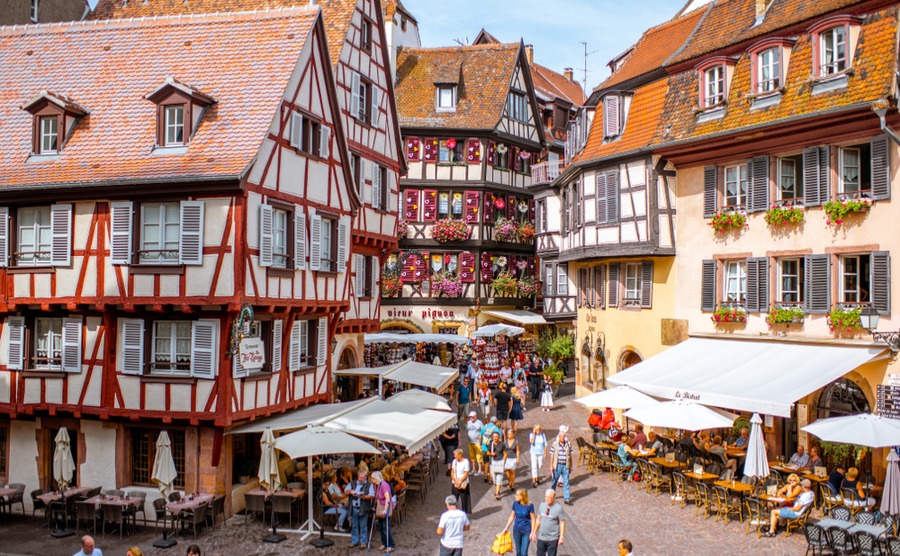
London to Colmar can take as little as 5hrs 20 in a train! RossHelen / Shutterstock.com
With its architectural wonders, sunny climate and situation to the east of the Vosges mountain range, Colmar is a popular tourist destination for culture buffs, oeneologues and walkers. The town is situated on the Alsatian Wine route which can be navigated by cycle as well as by car. The fastest journey time between London and Colmar is around 5 hours 20 minutes and property prices are in the €2,000 per square metre range.
Find homes in France via our property portal.
Biarritz
A mecca for surfers, Biarritz is situated in the Basque region of France. Situated amidst glorious land- and seascapes, there’s plenty for nature lovers to do, and you can tuck hearty Spanish-influenced cuisine after catching the waves or hiking the trails of the Pyrenees. Trains to Biarritz take about 7.30, travelling via Paris, and a home will cost around €5,000 per square metre.
Lille
An underrated city at the Northern tip of France, Lille’s Flemish-inspired architecture and dishes such as Moules Frites make it a popular tourist destination. Lille also boasts a splendid fine art museum and an avant-garde cathedral. Travel time from London is a mere 1 hour 22 minutes, and property costs an average of €2,500 per square metre.


